Hair Coloring Temperature

A: Usually, the application of heat to the head when performing a color service is to help speed the lightening of the hair by the developer in the color mixture. Heat will speed up the "lifting action" of the color mix, ensuring that the color lightens evenly all over.
Whether or not the colorist uses heat to help with the processing may also depend on the strength of the developer used and the desired color. Sometimes, when the colorist is only performing a retouch to previously colored hair, he or she will not use heat when he or she may have done so previously to prevent further lightening of the already colored hair. The heat of the scalp will have made sure that the new growth lightened sufficiently to match the rest of the hair.
Heat may also be used on the hair when coloring if the hair has proven to be resistant to hair color in the past. This may be the case when dealing with gray hair or other hair that is typically resistant to chemical processing.
©Hairfinder.com
See also:
How to color hair
What does the developer do?
Hair color levels and peroxide developer
